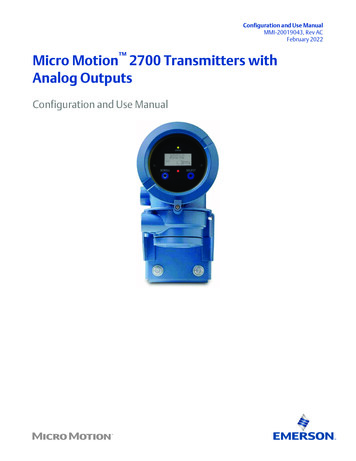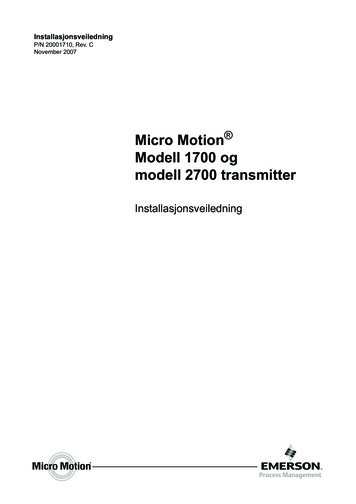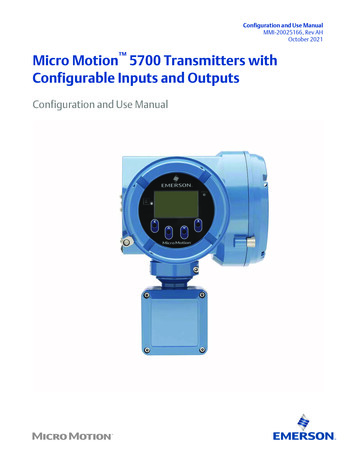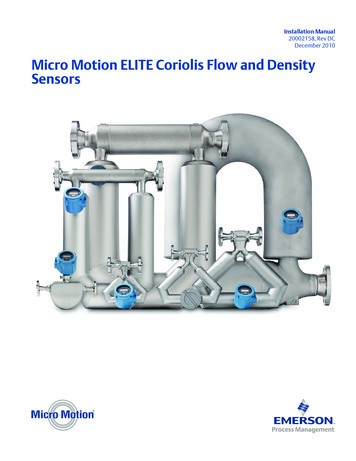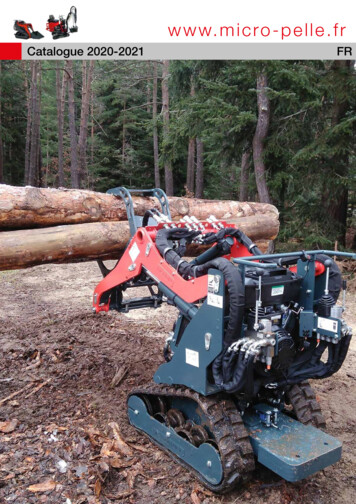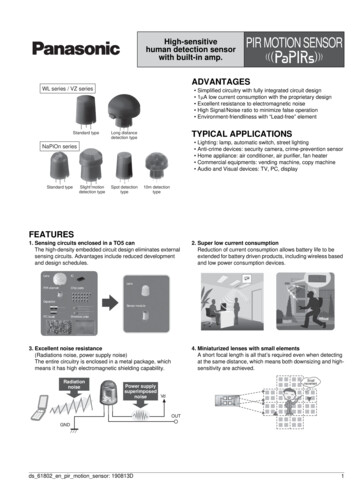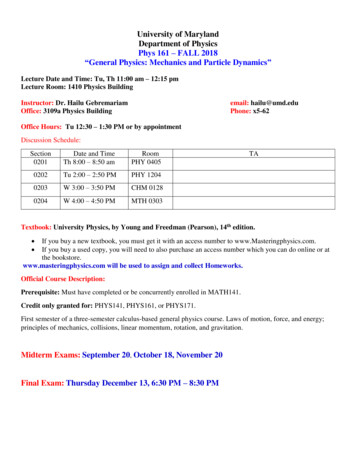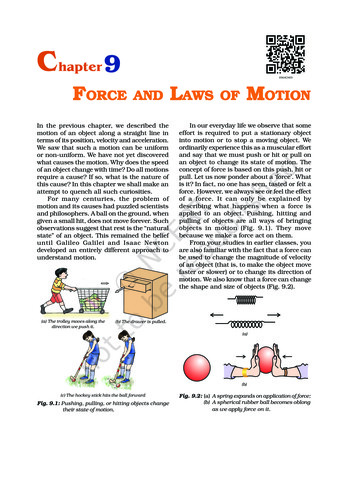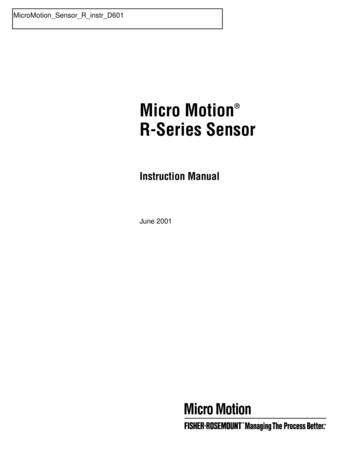
Transcription
MicroMotion Sensor R instr D601Micro MotionR-Series Sensor Instruction ManualJune 2001
Micro MotionR-Series Sensor Instruction ManualFor technical assistance, phone the Micro Motion CustomerService Department: In the U.S.A., phone 1-800-522-6277, 24 hours Outside the U.S.A., phone 303-530-8400, 24 hours In Europe, phone 31 (0) 318 549 443 In Asia, phone 65-770-8155Copyright 2001, Micro Motion, Inc. All rights reserved.Micro Motion and ProLink are registered trademarks of Micro Motion, Inc., Boulder,Colorado.HART is a registered trademark of the HART Communication Foundation, Austin,Texas.Modbus is a registered trademark of Modicon, Inc., North Andover, Massachusetts.FOUNDATION is a trademark of the Fieldbus Foundation, Austin, Texas.
ContentsUsing This Manual.iiiBefore You Begin . . . . . . . . . . . . . . . . . . . . . . . . . . . . . . . . . .1Your new sensor. . . . . . . . . . . . . . . . . . . . . . . . . . . . . . . . . . . . .The installation process . . . . . . . . . . . . . . . . . . . . . . . . . . . . . . .Additional information . . . . . . . . . . . . . . . . . . . . . . . . . . . . . . . . .144Step 1. Location . . . . . . . . . . . . . . . . . . . . . . . . . . . . . . . . . . .5Pipe run . . . . . . . . . . . . . . . . . . . . . . . . . . . . . . . . . . . . . . . . . . .Cable to transmitter . . . . . . . . . . . . . . . . . . . . . . . . . . . . . . . . . .Temperature, humidity, and vibration . . . . . . . . . . . . . . . . . . . . .Valves. . . . . . . . . . . . . . . . . . . . . . . . . . . . . . . . . . . . . . . . . . . . .Hazardous area installations . . . . . . . . . . . . . . . . . . . . . . . . . . .55677Step 2. Orientation.Flow direction . . . . . . . . . . . . . . . . . . . . . . . . . . . . . . . . . . . . . . .Integrally mounted transmitter and display . . . . . . . . . . . . . . . . .Sensor junction box . . . . . . . . . . . . . . . . . . . . . . . . . . . . . . . . . .Orientation of the conduit opening of the core processor . . . . . .Process fluid . . . . . . . . . . . . . . . . . . . . . . . . . . . . . . . . . . . . . . . .Step 3. Mounting9910101012.13.Hazardous area installations . . . . . . . . . . . . . . . . . . . . . . . . . . .Wiring the sensor . . . . . . . . . . . . . . . . . . . . . . . . . . . . . . . . . . . .Sensor grounding . . . . . . . . . . . . . . . . . . . . . . . . . . . . . . . . . . . .Sensor 4-wire connection . . . . . . . . . . . . . . . . . . . . . . . . . . . . . .Sensor 9-wire connection . . . . . . . . . . . . . . . . . . . . . . . . . . . . . .15Step 4. Wiring1516161719Step 5. Startup. . . . . . . . . . . . . . . . . . . . . . . . . . . . . . . . . . . . . 21Zeroing . . . . . . . . . . . . . . . . . . . . . . . . . . . . . . . . . . . . . . . . . . . .Configuration, calibration, and characterization . . . . . . . . . . . . .Customer Service . . . . . . . . . . . . . . . . . . . . . . . . . . . . . . . . . . . .R-Series Sensor Instruction Manual212122i
Contents continuedTroubleshooting.General information. . . . . . . . . . . . . . . . . . . . . . . . . . . . . . . . . . .Zero drift . . . . . . . . . . . . . . . . . . . . . . . . . . . . . . . . . . . . . . . . . . .Erratic flow rate . . . . . . . . . . . . . . . . . . . . . . . . . . . . . . . . . . . . . .Inaccurate flow rate or batch total . . . . . . . . . . . . . . . . . . . . . . . .Inaccurate density reading . . . . . . . . . . . . . . . . . . . . . . . . . . . . .Inaccurate temperature reading . . . . . . . . . . . . . . . . . . . . . . . . .Troubleshooting at the transmitter . . . . . . . . . . . . . . . . . . . . . . .Troubleshooting at the sensor. . . . . . . . . . . . . . . . . . . . . . . . . . .232324252627282934R-Series Specifications. . . . . . . . . . . . . . . . . . . . . . . . . . . . 37Performance specifications . . . . . . . . . . . . . . . . . . . . . . . . . . . . .Performance specifications continued . . . . . . . . . . . . . . . . . . . .Functional specifications – all meters . . . . . . . . . . . . . . . . . . . . .Functional specifications – all meters continued . . . . . . . . . . . . .Functional specifications – all meters continued . . . . . . . . . . . . .Physical Specifications . . . . . . . . . . . . . . . . . . . . . . . . . . . . . . . .Physical specifications . . . . . . . . . . . . . . . . . . . . . . . . . . . . . . . .Physical specifications continued . . . . . . . . . . . . . . . . . . . . . . . .Physical specifications continued . . . . . . . . . . . . . . . . . . . . . . . .Physical specifications continued . . . . . . . . . . . . . . . . . . . . . . . .37404142434445464748Label Maintenance and Replacement . . . . . . . . . . . . 51Return Policy. . . . . . . . . . . . . . . . . . . . . . . . . . . . . . . . . . . . . . . 55Indexii.57R-Series Sensor Instruction Manual
Using This ManualSection titleSections inthis manualKeyIndicates themain idea tokeep in mindCurrentsectionTitle of illustrationor tableCaution statementDescribes hazards that could result inminor personal injury, product damage,or property damageorWarning statementDescribes hazards that could result inserious injury or deathR-Series Sensor Instruction Manualiii
ivR-Series Sensor Instruction Manual
Before You BeginBefore You BeginLocationYour new sensorYour new Micro Motion R-Series sensor is one part of a Coriolisflowmetering system. The other component of the flowmeter is atransmitter.WiringSensor componentsComponents of the sensor are illustrated on pages 2 and 3. Dimensionsare provided in Appendix A, page 37.MountingEuropean installationsR-Series sensors comply with EMC directive 89/336/EEC and lowvoltage directive 73/23/EEC, including all amendments, when properlyinstalled in accordance with the guidelines and instructions described inthis manual.OrientationTransmitter connectionsR-Series sensors may be connected to any of these Micro Motiontransmitters: Series 1000 or 2000 IFT9703 Model 5300R-Series sensors are available with four types of transmitter connectioninterfaces: Core processor for connection to a remotely mounted Series 1000 or2000 transmitter, or to a direct host Integrally mounted Model 1700 or 2700 A 9-wire junction box for connecting to a 9-wire Model 1700 or 2700transmitter Integrally mounted IFT9703 or Model 5300Startup1TroubleshootingR-Series Sensor Instruction Manual
Before You Begin continuedSensor with core processorCore processorCalibration tagApprovals andserial number tagProcessconnectionFlow directionarrowSensorhousingSensor with junction boxJunction boxCalibration tagApprovals andserial number tagProcessconnectionFlow directionarrowSensorhousing2R-Series Sensor Instruction Manual
Before You BeginBefore You Begin continuedSensor with integrally mounted Model 1700 or 2700 transmitterModel 1700 or 2700transmitterLocationApprovals andserial number tagCalibration tagProcessconnectionOrientationFlow directionarrowSensorhousingMountingSensor with integrally mounted IFT9703 or Model 5300 transmitterIFT9703 or Model5300 transmitterCalibration tagApprovals and serialnumber tagWiringProcessconnectionFLOWFlow R-Series Sensor Instruction Manual
Before You Begin continuedThe installation processInstalling your new sensor involves five steps:Step 1. LocationDetermining the proper location for the sensor, taking into accounthazardous areas, process piping, transmitter location, and valves. Seepage 5.Step 2. OrientationDetermining the desired orientation for the sensor in the processpipeline. See page 9.Step 3. MountingInstalling the sensor in the pipeline. See page 13.Step 4. WiringConnecting the flowmeter cable to the sensor and transmitter. Seepage 15.Step 5. StartupRequirements for flowmeter startup. See page 21.Additional informationIn addition to installation instructions, the following subjects are alsocovered in this manual: Troubleshooting for problems that might be attributable to the sensorbegins on page 23. Product specifications, including sensor dimensions and processconnection options, are listed in Appendix A, page 37. Maintenance of labels is explained in Appendix B, page 51. Return policy for Micro Motion equipment is described in Appendix C,page 55.4R-Series Sensor Instruction Manual
Before You BeginInstallationStep 1LocationLocationOrientationKeys for sensor locationThe sensor may be located anywhere in the process line, as long asthe following conditions are met: Before operation, you must be able to stop flow through the sensor.(During the zeroing procedure, flow must be stopped completely, andthe sensor tubes must be full of process fluid.) During operation, the sensor tubes must remain full of process fluid. The sensor must be installed in an area that is compatible with theclassification specified on the approvals tag. (See illustrations, onpages 2–3) If the sensor is equipped with an integrally mounted transmitter, youmust consider the environmental requirements of the integrallymounted transmitter, visibility of the transmitter display, and theclassification specified on the transmitter approvals tag.Micro Motion sensors do not require a straight run of pipe upstream ordownstream. If two identical sensors are installed in series, they must beat least 5 ft (1.5 m) apart.Cable to transmitterThe maximum wiring distances are shown in the table below.MountingPipe runW iring DistancesMaximum wiring distance60 ft (20m)1,000 ft (300 m)1,000 ft (300 m)WiringCable9-wire to a Model 1700 or 2700 transmitter9-wire to all other transmitters4-wire 18 AWG to a Model 1700 or 2700transmitter, or a direct host4-wire 20 AWG to a Model 1700 or 2700transmitter, or a direct host4-wire 22 AWG to a Model 1700 or 2700transmitter, or a direct host500 ft (150 m)300 ft (90 m)Startup5TrouleshootingR-Series Sensor Instruction Manual
Location continuedTemperature, humidity, andvibrationInstall the sensor according to specified limits.Process fluid temperature limitsProcess fluid temperature limits are –40 to 300 F (–40 to 150 C) forsensors with a junction box.Process fluid temperature limits are –40 to 257 F (–40 to 125 C) forsensors with a core processor or an integrally mounted IFT9703 orModel 5300 transmitter. If the process fluid temperature is going toexceed this temperature, you must use a junction box model sensor witha 9-wire Series 1000 or 2000 transmitter.Ambient temperature limits For sensors with a core processor:- operating temperature limits of –40 to 140 F (–40 to 60 C) For sensors with an integrally mounted transmitter- Model 1700 or 2700 transmitter—operating temperature limits of:–40 to 140 F (–40 to 60 C)- IFT9703 or Model 5300 transmitter:- With optional display (IFT9703 only): 32 to 131 F (0 to 55 C)- Without display: –22 to 131 F (–30 to 55 C) For sensors with a junction box:- –22 to 131 F (–30 to 55 C)At their upper limits, process fluid temperature and ambient temperaturerestrict each other.Environmental limits on electronics Humidity limits: 5 to 95% non-condensing Vibration limits: per IEC 68.2.6, 2 g, endurance sweep, 10 to 2000 Hz,50 sweep cyclesEffect of ambient temperature on maximum process fluid temperature for sensors with an IFT9703 or Model5300 transmitterExpected maximumambient temperature, F ( C)150 (66)Maximum, with noexternal heat source130 (54)110 (43)Maximum, when mountedin direct sunlight90 (32)70 (21)158 (70)176 (80)194 (90)212 (100) 230 (110) 248 (120) 266 (130)Process fluid temperature, F ( C)6R-Series Sensor Instruction Manual
Before You BeginLocation continuedAfter the sensor and transmitter have been fully installed, you mustperform the zeroing procedure. During the zeroing procedure, flowthrough the sensor must be halted and the sensor tubes must becompletely full of process fluid. A shutoff valve, downstream from thesensor, is recommended to halt flow during the zeroing procedure. Formore information about zeroing, see page 21.Hazardous area installationsTo comply with requirements for an intrinsically safe (I.S.)installation, you must use a Micro Motion I.S. installation instructionmanual when installing the sensor in a hazardous area. An I.S. manualis shipped with an approved flowmeter.LocationValvesOrientationA complete list of hazardous area classifications for Micro MotionR-Series sensors is provided on page 42.To obtain a copy of an I.S. manual via the World Wide Web, go to: www.micromotion.comIf you don’t have access to the World Wide Web, you can obtain an I.S.manual by contacting the Micro Motion Customer Service Department:Mounting In the U.S.A., phone 1-800-522-MASS (1-800-522-6277) Outside the U.S.A., phone 303-530-8400 In Europe, phone 31 (0) 318 549 443 In Asia, phone 65-770-8155WiringStartup7TrouleshootingR-Series Sensor Instruction Manual
8R-Series Sensor Instruction Manual
Before You BeginInstallationStep 2O rientationLocationKeys for sensor orientationThe sensor will function properly in any orientation if the sensor flowtubes remain filled with process fluid.OrientationFlow directionMicro Motion sensors measure accurately regardless of flow direction.Flow direction arrowThe sensor features a flow direction arrow (see illustration below), butthe sensor will measure flow in either direction.Vertical pipelineIf the sensor is installed in a vertical pipeline, liquids and slurries shouldflow upward through the sensor. Gases may flow upward or downward.MountingIf the process fluid flows in the direction opposite to the flow directionarrow, flowmeter outputs might not behave as expected unless thetransmitter is configured appropriately. For more information, includingconfiguration instructions, refer to the transmitter instruction manual.Flow direction arrowWiringFLO W9TrouleshootingR-Series Sensor Instruction ManualStartupFlow directionarrow
O rientation continuedIntegrally mounted transmitterand displayIf the transmitter is integrally mounted to the sensor, the transmitter anddisplay can be independently rotated for easier access or greatervisibility. For information about rotating the transmitter or display, see theinstruction manual shipped with the transmitter.Sensor junction boxIf the sensor has a junction box, you will need to connect a 9-wireflowmeter cable to the sensor junction box and the transmitter.If possible, install wiring with the junction box opening pointed down, orinstall a drip leg in the conduit, to reduce the risk of condensation orexcessive moisture in the junction box.Standard junction boxJunction boxO rientation of the conduitopening of the core processorIf the sensor has a core processor and is used with a remotely mountedtransmitter, you will need to connect a 4-wire cable or two shielded 2wire cables between the core processor and a Series 1000 or 2000transmitter.WARNINGTwisting the core processor will damage the sensor.Do not twist the plastic wiring module inside the coreprocessor.Before wiring is attached, the core processor conduit ring rotatesindependently from the terminals inside. Rotate only the conduit ring,and not the entire core processor. If the entire core processor is rotatedthe sensor will be damaged.10R-Series Sensor Instruction Manual
Before You BeginO rientation continuedTo orient the conduit opening:1. Remove the core processor cover.Location2. Rotate the conduit ring a maximum of ¼ turn to orient the conduitopening. Do not twist the plastic module inside the core processor.R-series core hootingR-Series Sensor Instruction Manual
O rientation continuedProcess fluidTypical sensor orientations are shown below: For measuring liquids, see row 1. For measuring gases, see row 2. For measuring slurries, see row 3.O rientation for R-Series sensorsFluid beingmeasuredLiquidsPreferred orientationTubes downHorizontal pipelineAlternative orientationsFlag mountVertical pipelineSelf-drainingTubes upHorizontal pipelineSelf-drainingFlowGasesSlurriesTubes upHorizontal pipelineFlag mountVertical pipelineFlag mountVertical pipelineSelf-drainingTubes upHorizontal pipelineSelf-drainingFlow12R-Series Sensor Instruction Manual
Before You BeginInstallationStep 3MountingLocationKeys for sensor mountingUse your common piping practices to minimize: Torque on process connections Bending load on process connectionsOrientationMounting any R-Series sensorMountingFor proper orientation, seepage 9WiringStartupCAUTIONUsing the sensor to support pipingcan damage the sensor orcause measurement error.Do not use sensor to support pipe.13TrouleshootingR-Series Sensor Instruction Manual
14R-Series Sensor Instruction Manual
Before You BeginInstallationW iringHazardous area installationsTo comply with requirements for an intrinsically safe (I.S.) installation,you must use the appropriate Micro Motion I.S. installation instructionmanuals, in addition to this manual, when wiring the sensor in ahazardous area. An I.S. manual is shipped with an approved flowmeter.WARNINGFailure to comply with requirements for intrinsicsafety in a hazardous area could result in anexplosion.Mounting Make sure the hazardous area specified on the sensorapprovals tag is suitable for the environment in which thesensor is installed. See illustration, page 2. For installation in an area that requires intrinsic safety,use this document with Micro Motion UL, CSA,installation instructions. For hazardous area installations in Europe, refer tostandard EN 60079-14 if national standards do not apply.OrientationFor hazardous area installation in Europe, use standard EN 60079-14 asa guideline if national standards are not in effect.LocationStep 4To obtain a copy of an I.S. manual via the World Wide Web, go to: www.micromotion.comWiringIf you don’t have access to the World Wide Web, you can obtain an I.S.manual by contacting the Micro Motion Customer Service Department: In the U.S.A., phone 1-800-522-MASS (1-800-522-6277) Outside the U.S.A., phone 303-530-8400 In Europe, phone 31 (0) 318 549 443 In Asia, phone 65-770-815515TrouleshootingR-Series Sensor Instruction ManualStartupA complete list of UL, CSA, and European approvals for R-Seriessensors is provided on page 42.
W iring continuedW iring the sensorIf the sensor has a junction box, see the cable preparation instructionsthat are shipped with the sensor cable.If the sensor is integrally mounted to a Model 1700 or 2700 transmitterwith a core processor or to an IFT9703 or Model 5300 transmitter, nosensor to transmitter wiring is required.If the sensor has a core processor, see Sensor 4-wire connection, page17Sensor groundingGround the sensor and transmitter independently.The sensor can be grounded via the piping, if joints in the pipeline areground-bonded, or by means of a ground screw on the outside of thecore processor or junction box housing.CAUTIONImproper grounding could cause measurement error.To reduce the risk of measurement error: Ground the flowmeter to earth, or follow ground networkrequirements for the facility. For installation in an area that requires intrinsic safety,refer to Micro Motion UL, CSA, or CENELEC installationinstructions. For hazardous area installations in Europe, refer tostandard EN 60079-14 if national standards do not apply.If national standards are not in effect, adhere to these guidelines: Use copper wire, 14 AWG (2.5 mm2) or larger wire size. Keep all ground leads as short as possible. Ground leads must have less than 1 ohm impedance. Connect ground leads directly to earth, or follow plant standards.16R-Series Sensor Instruction Manual
Sensor 4-wire connectionShielded 4-wire or two shielded 2-wire cable should be used unless thecable is run in continuous metallic conduit.Before You BeginW iring continuedMaximum wire lengths are:Connect the four color-coded wires or shielded 2-wire cable wires to thenumbered core processor terminals. Connect the shield wire to theground screw.CAUTIONOrientationAt the transmitter, connect the opposite end of each color-coded wire tothe mating-connector slot with the same number as the core processorterminal. Refer to the transmitter instruction manual for complete wiringinstructions.Location 300 ft (100 m) of 22 AWG (0.35 mm) 1,000 ft (300 m) of 18 AWG (0.8 mm)Failure to seal the core processor and transmitterhousing could cause a short circuit, which wouldresult in measurement error or flowmeter failure.MountingTo reduce risk of condensation or excessive moisture inthe core processor or transmitter housing: Seal all conduit openings. Install drip legs in conduit or cable. Fully tighten core processor cover and all transmitterhousing covers.Wiring the core processor to a remote host and power supply otherthan a Model 1700 or 2700 transmitterWiringThe power supply must not supply any load other than a core processor(s). The power supply outputs must not be connected to an externalground. The power supply and/or the communications host must notallow any electromagnetic interference to be coupled onto the four wiresto the core processor. A recommended power supply is the SDN seriesof 24 VDC power supplies manufactured by Sola/Hevi-Duty.Startup17TrouleshootingR-Series Sensor Instruction Manual
W iring continuedW iring the 4-wire core processor to the Model 1700 or 2700 transmitterR-Series sensorcore processorterminalsVDC FlowmetercableRS485B4-wire field-mountModel 1700 or 2700terminalsMaximum cable length 18 AWG 1000 ft (300 m)Maximum cable length 20 AWG 500 ft (150 m)Maximum cable length 22 AWG 300 ft (90 m)VDC VDCUser-supplied cableRS485ARS485BVDC-18RS485AR-Series Sensor Instruction Manual
Sensor 9-wire connectionThe instructions in this section explain how to connect a fully prepared9-wire Micro Motion flowmeter cable to the sensor and transmitter. The procedure for preparing Micro Motion cable and cable glands isdescribed in the instructions that are shipped with the cable. Install cable and wiring to meet local code requirements.CAUTIONFailure to seal the sensor junction box and transmitterhousing could cause a short circuit, which wouldresult in measurement error or flowmeter failure.To reduce risk of condensation or excessive moisture inthe junction box or transmitter housing: Seal all conduit openings. Install drip legs in conduit or cable. Fully tighten sensor junction box cover and all transmitterhousing covers.Cable connections to the sensor and transmitterThe wiring procedure is the same for the sensor and transmitter. Refer tothe wiring diagrams on page 18, and follow these steps:1. Locate the wires by color.2. Insert the stripped ends of the individual wires into the terminalblocks. No bare wires should remain exposed. At the sensor, connect wiring inside the junction box or coreprocessor housing. At the transmitter, connect wiring to the transmitter’s intrinsically safeterminals for sensor wiring.3. Tighten the screws to hold the wires in place.4. Ensure integrity of gaskets, then close the junction box or coreprocessor cover and tighten all screws. Tightly close all housingcovers on the transmitter.CAUTIONDrain wires from a 9-wire cable must be clipped at thesensor end and insulated with heat-shrink wrapping.Failure to properly terminate drain wires will causesensor error.19R-Series Sensor Instruction Manual
W iring the 9-wire junction box to the Model 1700 or 2700 field-mount transmitterR-Series sensor9-wire junction boxterminalsFlowmetercableMaximum cable length 60 ft. (20 nRedClip drain wire backGreenWhiteClip drain wire backBlueGrayClip drain wire backOrangeVioletYellowClip drain wire back9-wire field-mountModel 1700 or 2700terminalsBlack(Drains from allwire lackGround repare cable in accordance with theinstructions that are shipped with the cable.Do not allow shields to contact sensorjunction box.20R-Series Sensor Instruction Manual
Before You BeginInstallationStartupZeroingAfter the flowmeter has been fully installed, you must perform thezeroing procedure. Flowmeter zeroing establishes flowmeter responseto zero flow and sets a baseline for flow measurement. Refer to thetransmitter instruction manual for information on performing the zeroingprocedure.OrientationCAUTIONLocationStep 5Failure to zero the flowmeter at initial startup couldcause measurement error.Zero the flowmeter before putting the meter in operation.Configuration, calibration, andcharacterizationYou can use the transmitter to configure, calibrate, and characterize themeter. For more information, refer to the transmitter instruction manuals.MountingThe following information explains the difference between configuration,calibration, and characterization. Certain parameters might requireconfiguration even when calibration is not necessary.Configuration parameters include such items as measurement units,flow direction, damping values, and slug flow parameters. If requested attime of order, the meter is configured at the factory according tocustomer specifications.WiringCalibration accounts for the flowmeter’s sensitivity to flow, density, andtemperature. Calibration is done at the factory.Characterization is the process of entering calibration factors for flow,density, and temperature directly into transmitter memory, instead ofperforming field calibration procedures. Calibration factors can be foundon the sensor serial number tag and on the certificate that is shippedwith the sensor.Startup21TrouleshootingR-Sensor Sensor Instruction Manual
Startup continuedThe following manuals include instructions for flowmeter configuration,calibration, and characterization: Using the HART Communicator with Micro Motion Transmitters Using ProLink Software with Micro Motion Transmitters Using ProLink II Software with Micro Motion Transmitters IFT9703 Transmitter Instruction Manual Model 5300 Transmitter with FOUNDATION fieldbus Series 1000 and 2000 Transmitter ManualsCustomer ServiceThe Micro Motion Customer Service Department is available forassistance with flowmeter startup if you experience problems you cannotsolve on your own.For help online, use the Micro Motion Expert2 system at:www.micromotion.comOr telephone Micro Motion at: In the U.S.A., phone 1-800-522-MASS (1-800-522-6277), 24 hours Outside the U.S.A., phone 303-530-8400, 24 hours In Europe, phone 31 (0) 318 549 443 In Asia, phone 65-770-8155If possible, provide us with the model numbers and/or serial numbers ofyour Micro Motion equipment, which will assist us in answering yourquestions.22R-Sensor Sensor Instruction Manual
Before You BeginTroubleshootingLocationGeneral informationFor troubleshooting help, see the Expert2 system online atwww.micromotion.com.If you cannot find the problem you are looking for, check the transmitterinstruction manual or one of the following manuals: Using the HART Communicator with Micro Motion Transmitters Using ProLink Software with Micro Motion Transmitters Using ProLink II Software with Micro Motion TransmittersMountingYou can also use Fisher-Rosemount Asset Management Solutions(AMS) software to troubleshoot Micro Motion flowmeters. Forinstructions on using AMS software, refer to the AMS on-line help.OrientationMost troubleshooting is performed at the transmitter. However, thefollowing troubleshooting topics are described in this manual: Zero drift, page 24 Erratic flow rate, page 25 Inaccurate flow rate or batch total, page 26 Inaccurate temperature reading, page 28WiringTo troubleshoot the flowmeter, you might need a digital multimeter(DMM) or similar device, the transmitter display, if it has one; and one ofthe following: HART Communicator ProLink software AMS software Modbus master controller Fieldbus host controller Profibus hostIf you cannot find the problem you are looking for, or if troubleshootingfails to reveal the problem, contact the Micro Motion Customer ServiceDepartment.23TrouleshootingR-Series Sensor Instruction ManualStartupIf possible, provide us with the model numbers and/or serial numbers ofyour Micro Motion equipment, which will assist us in answering yourquestions. In the U.S.A., phone 1-800-522-MASS (1-800-522-6277), 24 hours Outside the U.S.A., phone 303-530-8400, 24 hours In Europe, phone 31 (0) 318 549 443 In Asia, phone 65-770-8155
Troubleshooting continuedZero driftSymptomThe flowmeter indicates the process fluid is flowing while flow isstopped; or indicates a flow rate that does not agree with a referencerate at low flow, but does agree at higher flow rates.Troubleshooting instructionsTo troubleshoot zero drift, you will need one of the communicationsdevices listed on page 29 or a transmitter with a display. Refer to thetable below for the necessary steps to troubleshoot zero drift.Troubleshooting zero driftProcedure1. Check for leaking valves and sealsInstructionsWhat to do next If no leaks are found, go to step 2 If leaks are found, eliminate them, then go to step 152. Check the flow unitsSee page 29 If the flow units are OK, go to step 3 If the flow units are wrong, change them, then go to step 153. Make sure the flowmeter waszeroed properlySee page 21 If the flowmeter was zeroed properly, go to step 4 If the flowmeter was not zeroed properly, zero it, then goto step 154. Check for the proper flowcalibration factorSee page 31 If the flow cal factor is correct, go to step 5 If the flow cal factor is incorrect, change it, then go to step 155. Check the damping valueSee page 32 If the damping value is OK, go to step 6 If the damping value is too low, change it, then go to step 156. Check for two-phase flowSee page 35 If there is no two-phase flow, go to
A complete list of hazardous area classifications for Micro Motion R-Series sensors is provided on page 42. To obtain a copy of an I.S. manual via the World Wide Web, go to: www.micromotion.com If you don't have access to the World Wide Web, you can obtain an I.S. manual by contacting the Micro Motion Customer Service Department:

